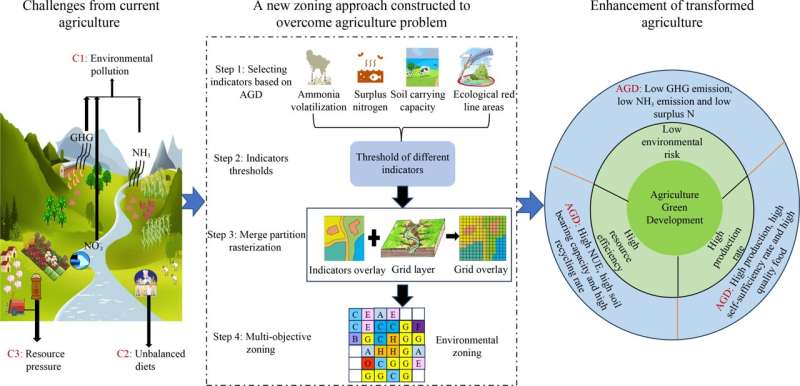This article has been reviewed according to Science X's editorial process and policies. Editors have highlighted the following attributes while ensuring the content's credibility:
fact-checked
proofread
How do crop–livestock systems switch to agricultural green development in the Baiyangdian Basin?

Excessive nitrogen input into agriculture systems has caused environmental problems such as atmospheric pollution, loss of biodiversity and degradation of water. Meanwhile, the development of intensive animal farming has further caused the separation between crop and livestock sectors, leading to additional hotspot areas prone to pollutant discharge.
The nutrient management optimization program addresses the multi-objective challenges within the food system, incorporating the concept of agricultural green development (AGD). In the pursuit of AGD, the quality of both human living environment (habitation) and the natural environment (including water, air and soil) become highly important.
However, when nutrient management aims to simultaneously protect soil, water and the atmosphere, conflicts may arise. These conflicts often result from the complicated interplay between measures targeting air or water loss and the necessary adjustments required in different spatial areas. Yet optimized management of crop–livestock systems that use multi-objective zoning is lacking.
Associate Professor Wenqi Ma from Hebei Agricultural University and Professor Lin Ma from Agricultural Resources Research Center, Institute of Genetics and Developmental Biology, Chinese Academy of Sciences, as well as their research teams, took the Baiyangdian Basin as a typical case study to establish a multi-objective zoning method, and explored the optimal approach of nutrient management for the green transformation of agricultural in basins.
The study has been published in Frontiers of Agricultural Science and Engineering.
By using the NUFER (nutrient flows in food chains, environment and resources use) model, researchers quantified the thresholds for these environmental indicators and determined the current levels of environmental emissions in the Baiyangdian Basin. They analyzed different scenarios and their potential for reducing environmental impacts, thus realizing AGD.
The study considered a range of environmental indicators that directly impact human health, the production of high-quality goods, and environmental characteristics. It identified four specific indicators, namely ammonia volatilization, surplus nitrogen, soil carrying capacity and ecological red line areas, which are pivotal for optimizing the crop–livestock systems.
A correlation between ammonia emission and PM2.5 was established through the utilization of geographically weighted regression analysis. The ammonia volatilization threshold was further calculated according to population density. Nitrogen surplus in the basin was determined by overlaying the grid maps representing slope and river distance in the Baiyangdian Basin. The threshold value of nitrogen surplus is determined by the value of nitrogen in the watershed and the critical value of runoff or leaching in the nitrate vulnerable zone within the county.
Soil carrying capacity refers to the ratio of nitrogen excreted by livestock to the nitrogen harvested by crops in the area. The critical value is when the nitrogen excreted by livestock and the nitrogen harvested by crops reach a balance. Then, according to the comparison between the current situation and the threshold value, areas that exceeded the threshold were classified as high, while areas that were below the threshold value were classified as low. Areas were divided into eight categories, each representing a unique combination of the three indicators, along with one ecological red line area.
To explore ways to optimize nutrient management, three scenarios were developed to evaluate potential emission reductions: (1) CS, the current situation scenario in which a comprehensive assessment of environmental indicators in the Baiyangdian Basin was made based on statistical data; (2) UT, the government's highly-recommended unified management technology in which the whole region adopts the model of integrating agriculture and livestock, mainly promoted by the state, to facilitate the recycling of nutrients in crop–livestock systems, aiming to reduce nutrient input requirements and promote efficient nutrient recycling; and (3) ZM, a management technology applications based on zoning partition management which is based on the unified policy, targeted emission reduction technologies are employed for zone-specific optimal management based on the distinctive characteristics of each zone.
Based on the results, it can be seen that after implementing UT, the proportion of counties within safe districts increased from 8% to 21%, while the high-risk zone (double-high zone) only decreased by less than 6%. Continuing with further application of ZM, more than 55% of the counties in the Baiyangdian Basin have achieved more environmentally friendly emissions, with all three indicators falling within the threshold values.
However, there are still some areas that exceed the safety threshold. Specifically, 10.5% of counties continued to have high ammonia emissions, 18.4% have high nitrogen surplus and 15.8% have both. The multi-objective zonal management optimization approach was more helpful to realize the environmental green emission of the crop–livestock systems in basins.
This system approach not only provides an effective way to address the challenges in Baiyangdian Basin, but also offers a potential way to meet the current challenges in agricultural systems in China, and thereby help the country to transform to more environmentally friendly agriculture systems. Agriculture transformed in such a way can protect natural resources, reduce pollution and improve resource use efficiency, while maintaining food security.
More information: Toward to agricultural green development by multi-objective zoning and nitrogen nutrient management: a case study in the Baiyangdian Basin, China, Frontiers of Agricultural Science and Engineering (2024). DOI: 10.15302/J-FASE-2023533
Provided by Frontiers Journals





















